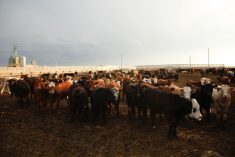Compared to last week, western Canadian yearling prices were $4-$6 lower; mid-weight feeder cattle traded $2 higher to $4 lower. Lighter calves and grassers were quite variable. In Alberta, these cattle ranged from unchanged to as much as $8 higher on average while in the eastern Prairie regions, calves traded $4 lower to $4 higher.
There are three distinct price structures in the feeder cattle complex. The value for each weight category is determined by the timeframe when the animal will come on the fed market. Heavier yearlings that will be sold in the late-summer timeframe are under pressure due to the backlog of market-ready supplies of fed cattle on both sides of the border. Feeders that will be sold on the fed market from September through December have a neutral price outlook because buyers expect the slaughter capacity to return to normal by this time. Calves and grass cattle that will be sold December 2020 forward are being supported by projections for a year-over-year decline in beef production.
Read Also

Alberta crop conditions improve: report
Varied precipitation and warm temperatures were generally beneficial for crop development across Alberta during the week ended July 8, according to the latest provincial crop report released July 11.
In central Alberta, mixed steers with medium to heavier flesh levels weighing 950 lbs. were valued at $140 and similar-quality heifers weighing just under 900 lbs. were valued at $130. In Manitoba, black medium- to larger-frame steers with heavier butter averaging 890 lbs. were reported at $155 and Simmental-based heifers weighing 900 lbs. were quoted at $137. In southern Alberta, Angus-blended steers weighing just over 850 lbs. were valued at $152 landed in the feedlot. A local auction near Lethbridge reported black heifers weighing 872 lbs. sold for $161.50. Again, the timing when these animals will hit the fed market is a main factor determining feedlot bids.
In eastern Saskatchewan and Manitoba, demand for grassers appears to have eased but stronger buying interest was evident across Alberta and western Saskatchewan. Black mixed steers weighing 650 lbs. were valued at $204 in southern Manitoba; in the Feedlot Alley region of Alberta, red steers averaging 660 lbs. were valued at $215 and red heifers weighing just over 550 lbs. were quoted at $211.
The feed grains complex is moving through a major fundamental shift which is also a contributing factor to the feedlot bids for each weight category. Barley prices are set to drop by nearly $20-$40 per tonne between now and new-crop positions. Central Alberta and a large portion of southern Saskatchewan have received less than 40 per cent of normal precipitation over the past 30 days. It’s been very windy in southern Alberta. Pen conditions are favourable but grass ratings are uncertain because the 30-day forecast is on the drier side.
— Jerry Klassen manages the Canadian office of Swiss-based grain trader GAP SA Grains and Produits Ltd. and is president and founder of Resilient Capital, specializing in proprietary commodity futures trading and market analysis. Jerry consults with feedlots on risk management and writes a weekly cattle market commentary. He can be reached at 204-504-8339 or via his website at ResilCapital.com.















